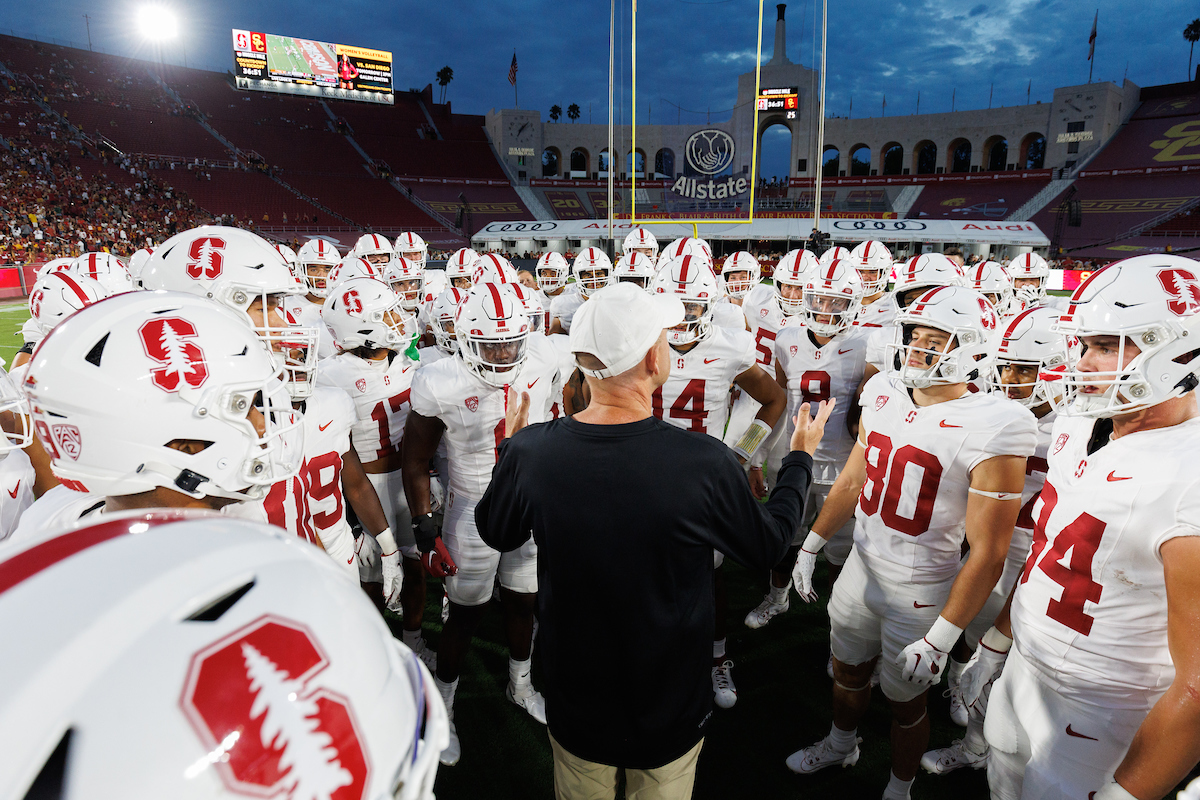The first loss of the Troy Taylor era was ugly: the USC Trojans (3-0, 1-0 Pac-12) dominated Stanford (1-1, 0-1 Pac-12) 56-10 at the Los Angeles Coliseum, in their last matchup as Pac-12 foes.
The Trojans’ explosive offense scored on all but one possession in the first half, helping build a 49-3 lead before halftime. 56 total points is the most Stanford has ever allowed USC. While a loss against No. 6 USC is in no way an indictment on Taylor, especially this early in his role, the game provided valuable insights into Stanford’s football program and current team.
1. Stanford’s defense looked porous against the Trojans’ high-flying attack
There are some players on Stanford’s defense with NFL potential, including sophomore defensive end David Bailey, but the team’s defense does not compare to the weapons USC has at its disposal. Trojan receivers Dorian Singer, Mario Williams and Brenden Rice will likely hear their name called during next year’s NFL draft.
Freshman receiver Zachariah Branch already looks like the second coming of Reggie Bush in just his third college game. I have not even mentioned the former Heisman winner Caleb Williams, who looked like a point guard on turf, distributing the ball quickly to his playmakers.
No matter what adjustments Stanford made in last week’s game, USC powered through with a roaring offense. When Stanford went to dime packages on defense, the Trojans ran the football through the teeth of the Cardinal defense. When Stanford sat back in zone, USC attacked the defense through run-pass options, flat routes and other Cover three and Cover four beaters. It did not help that the Cardinal could not draw a pass rush.
Asking any team to defend against USC is a tall task, but it is made even more challenging without similarly talented linemen and defensive backs. With academic restrictions that limit the pool of players Stanford can recruit, Taylor will have to hit on his recruits with a very high-accuracy rate in order to compete with the blue bloods.
2. The USC defense shut down Stanford TE Ben Yurosek
Coming off a game where he had nine receptions for 138 yards, it was perhaps unsurprising that senior tight end Ben Yurosek was the number one target for USC’s sophomore quarterback Ashton Daniels. USC did its homework and the Trojans were able to lock up the six-foot-four tight end for most of the game. While the 242-pound tight end from Bakersfield, Calif. finished the game with four receptions for 54 yards, that does not tell the complete story.
From the film, it appears USC defensive coordinator Alex Grinch called an aggressive match-up zone that allowed underneath defenders to jump routes, particularly when they were on Yurosek. The Trojans were able to get their hands on balls coming Yurosek’s way numerous times and when the tight end did catch the ball, he was immediately wrapped up by a USC defender. To avoid a predictable offense, more receivers will have to step up when Stanford gets into the thick of conference play.
3. Stanford’s offense seemed less cohesive without quarterback Ashton Daniels
Daniels suffered an injury early in the second quarter, which knocked him out for the rest of the game. After Daniels went down, Syracuse transfer Justin Lamson took the helm at quarterback. The offense didn’t operate as smoothly with Lamson and the Cardinal lacked a dynamic athlete who could make quick decisions. While it is unfair to compare Lamson’s performance against a top-ten team to Daniels’s performance against a G5 team, the film makes it clear that Stanford’s gear is different when Daniels is in the game.
Lamson had some promising moments, including a few ambitious plays to bring the Cardinal into field-goal range numerous times. But he was unable to score in many of those drives.
It will be interesting to observe how Taylor’s play calling will change to protect Daniels from further exposure to injury.
The Cardinal hosts its first home game on Sept. 16, as it takes on Taylor’s former team Sacramento State (2-0, 0-0 Big Sky).
